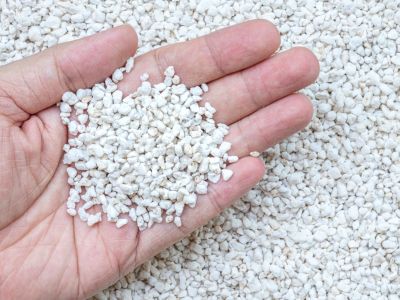How to Grow Plants in Perlite
Adding perlite to your vegetable beds or container garden keeps the soil loose and aids in aeration. Perlite is a lightweight, sterile material that doesn’t harbor pests and diseases. It doesn’t deteriorate and best of all, it’s non-toxic and is approved for organic gardening. The most common method for applying this soil additive to the garden is to top dress the ground with 2 to 4 inches (5 to 10 cm.) of a large or medium grade perlite. Then till or work it into the soil to a depth of 6 to 8 inches (15to 20 cm.). This works especially well with heavy, clay soils. Perlite is a natural material made by superheating volcanic glass until it expands. This forms a network of tiny air compartments within the perlite pellet. When added to soil, these tiny compartments retain moisture and oxygen.
Growing Plants in Perlite Only
Another use for perlite is in hydroponic gardening. As a growing medium, perlite is inexpensive, sterile and reusable. It’s also pH neutral, which makes it more convenient to use than growing mediums that require pH balancing. Many types of vegetables can be grown hydroponically using a 100% perlite medium. Naturally, we think of hydroponics for growing leafy crops such as lettuce, microgreens, spinach, kale, and arugula. Larger crops can also be cultivated using perlite in a Dutch or Bato bucket system. These include tomatoes, peppers, cucumbers, beans and eggplants.
Using Perlite in a Home Hydroponic System
Home gardeners looking for a hydroponic rooting medium find growing microgreens in perlite provides the correct mix of air and moisture to stimulate plant growth. Additionally, lettuce grown in perlite often produces larger heads with less tip burn compared to lettuce grown in other hydroponic mediums. Other hydroponic crops which benefit from perlite include tomatoes, which crack less than those grown in soil. Strawberries are reported to have more vigorous growth in perlite due to their need for higher levels of oxygen in their root zone.
Perlite and Potatoes
One vegetable home gardeners have often overlooked as a hydroponic crop is potatoes. Surprisingly, potatoes also grow quite nicely outdoors in a perlite-filled container during the summer. Root vegetables grown in perlite will be much cleaner at harvest than those grown in soil. To grow potatoes in perlite, begin by drilling holes about 2 inches (5 cm.) from the bottom of a large container. This provides a reservoir of water at the bottom of the container, but still allows excess moisture to drain. Next, fill the container with a fine or medium grade perlite. It’s advisable to wear a mask as perlite can be dusty and has the capacity to damage the respiratory system. Thoroughly wet the perlite, then plant seed potatoes as usual. Keep the perlite moist by watering as needed. When growing potatoes in perlite or using it for hydroponics, it’s necessary to add essential nutrients for growth and fruiting.
